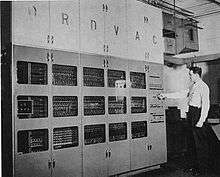ORDVAC

The ORDVAC or Ordnance Discrete Variable Automatic Computer, an early computer built by the University of Illinois for the Ballistics Research Laboratory at Aberdeen Proving Ground, was based on the IAS architecture developed by John von Neumann, which came to be known as the von Neumann architecture. The ORDVAC was the first computer to have a compiler. ORDVAC passed its acceptance tests on March 10, 1952 at Aberdeen Proving Ground in Maryland.[1] Its purpose was to perform ballistic trajectory calculations for the US Military.
Unlike the other computers of its era, the ORDVAC and ILLIAC I were twins and could exchange programs with each other. The later SILLIAC computer was a copy of the ORDVAC/ILLIAC series. J. P. Nash of the University of Illinois was a developer of both the ORDVAC and of the university's own identical copy, the ILLIAC, which was later renamed the ILLIAC I. Donald B. Gillies assisted in the checkout of ORDVAC at Aberdeen Proving Ground. After ORDVAC was moved to Aberdeen, it was used remotely by telephone by the University of Illinois for up to eight hours per night. It was one of the first computers to be used remotely and probably the first to routinely be used remotely.
The ORDVAC used 2178 vacuum tubes. Its addition time was 72 microseconds and the multiplication time was 732 microseconds. Its main memory consisted of 1024 words of 40 bits each, stored using Williams tubes. It was a rare asynchronous machine, meaning that there was no central clock regulating the timing of the instructions. One instruction started executing when the previous one finished.
ORDVAC and its successor at Aberdeen Proving Ground, BRLESC, used their own unique notation for hexadecimal numbers. Instead of the sequence A B C D E F universally used today, the digits ten to fifteen were represented by the letters K S N J F L (King Sized Numbers Just for Laughs), corresponding to the teleprinter characters on five-track paper tape.
Commissioning
When ORDVAC was completed, it was tested at the University of Illinois and then disassembled and shipped to Aberdeen Proving Ground in Maryland. Three faculty members including Sylvian Ray and Abe Taub drove to Maryland to help assemble the machine, which was reconstructed and passed its validation tests in just a week. It was expected that assembly and testing would take over a month. When some military officers came to check on the progress of Ordvac assembly, they asked, "Who is in charge here?", and were told, "It's the guy who is holding the broom!", as Abe Taub - the head of The University of Illinois Digital Computer Laboratory - was sweeping up after having completed all the necessary tasks.[2]
Details
- Memory uses 40 cathode ray tubes and 800 vacuum tubes, [3]:1
- Arithmetic unit uses 1100 vacuum tubes, [3]:2
- Control, uses about 500 vacuum tubes, [3]:3
Total of 2718 vacuum tubes, [3]:4
See also
References
- ↑ "The Computer from Pascal to von Neumann - Chapter 6, by Herman H. Goldstine". Princeton University Press. 1972. ISBN 0-691-08104-2.
- ↑ "No Boundaries:University of Illinois Vignettes - Chapter 15, by Sylvian Ray". University of Illinois Press. Retrieved 2008-07-24.
- 1 2 3 4 manual Vol 1
External links
- ORDVAC documentation at bitsavers.org